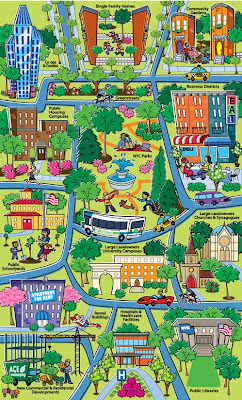Tuesday, December 16, 2008
Friday, October 31, 2008
Re: ARE WE REALLY READY FOR 'BOTTOM UP'?
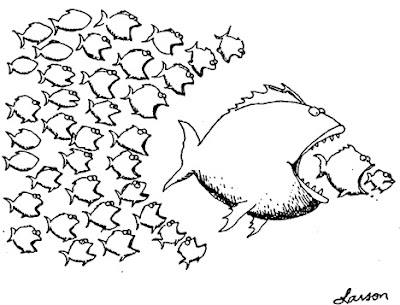
This week _urb_ (a blog I am reading a lot these days and I can really recommend) features a post on this question. I am personally dealing with this issue as well for quite a while. Since I am relased to the professional world I have been trying to bring the ideas of bottom-up 'design' closer to architects and clients, but my attempts are without success. That doesn't really answer the question but it substantiates suspicion that some ideas work better on an academic level and the so called 'real world' has nothing to do with that - or are we not ready yet?
image source
Friday, October 24, 2008
URBAN FOOD PRODUCTION

 Benedetta Garguilo :: Fish Faming
Benedetta Garguilo :: Fish FamingHere are two projects of last year's AA inter3 studio. Students were asked: Can extremes of programmatic effectiveness blend with the fragility of human habitat? Can food production be integrated into the fabric of the City?
Benedetta Garguilo dealt with fish farming in central london while Soonil Kim designed the King's Vineyard London

 Soonil Kim :: Vineyard
Soonil Kim :: VineyardThanks to pruned for the hint
related posts:
on urban agriculture here, here and here and on aqua-culture here and here
Sunday, October 12, 2008
YELLOW FOG
Friday, October 10, 2008
BIENNALE DI VENEZIA - ARSENALE
As expected, la Biennale di Venezia was a big show off of big names - at least at the main exhibition at Arsenale. Zaha, Frank, Hani, Greg... with few things which were new. While Greg Lynn's recycled toy furniture was quite interesting comprehending a good sense of humor, I was quite disappointed by Diller + Scofidio's installation - a ride through venice with a gondola filmed from rear and front. We know that already way back in the sixties from Valie Export.
 Greg Lynn Form ::image by disturbnet
Greg Lynn Form ::image by disturbnetAlso Zaha's and Patrick Schumacher's mobile Lotus home was a bit annoying, especially when you listened to Patrick Schumacher's Parametric manifesto where he talks about Parametrisim beeing the real new style after Modernism - Post-Modernism, Deconstructivism only where transitory styles. But the problem with the Lotus installation is, that it only is able to exist in a Modernist building, a white box or as well the beautiful Arsenale pavillion. But how would it look like in a curvy Zaha building? So what about this new style being so dependend on the old one?
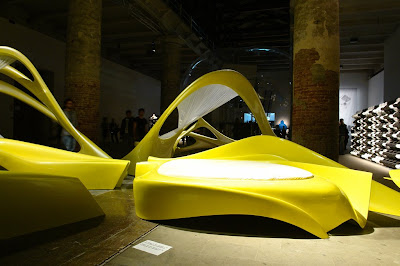 Zaha Hadid Architects::Lotus ::image by disturbnet
Zaha Hadid Architects::Lotus ::image by disturbnetUN Studio's 'The changing room' was at least more critical in the description.
Philippe Rahm showed again one of his Architecture and Meteorology installions, which I always like a lot although it did not work the time I was there.
A fresh cheer up on these exhaustive days was S1NGLETOWN by Droog Design focusing on the world of contemporary singles
I will post an entry from the Biennale dealing with issues of sustainability and landscape soon. So stay tuned..
Friday, October 3, 2008
Tuesday, September 30, 2008
Friday, September 12, 2008
WELCOME TO ARCADIA: public space belongs to whom? PART II
 This is Part II of Synchronicity's mini-feature showing different attitudes towards public space iin cities all over the globe. For this part we'll have a look on Mumbai.
This is Part II of Synchronicity's mini-feature showing different attitudes towards public space iin cities all over the globe. For this part we'll have a look on Mumbai.Mumbai's Dharavi area is a good example how public space in the area mis-developed, because not the interest of inhabitants came first, but the interest of a few companies. For hundred years Dharavi was a swampy no man's land, in the late 19th century inhabited by fishermen, occupied afterwards from immigrating people of the countryside. It became an almost real city district. The land was public; it needed not to be 'captured', because for a long time nobody was interested in that piece of ground at all. But Mumbai is growing fast and Dharavi is now one of the biggest slums in Asia and located almost in the centre of the city. So now private investors are interested in that 1,7 km2 piece of land, consequently the rents increase and the living space of 400.000 people was recently sold – by the city council. And soon this area will be characterised by cricket stadiums, office towers and shopping malls and lifestyle restaurants. The inhabitants were displaced – banished in fact.
There was an article in LA Times recently on Dhavari. Architect Mukesh Mehta is quoted in the LA Times as saying:
"You're talking of a location that's fantastic. This is the only location in Mumbai where I can bulldoze 500 acres of land and redesign."A fabulous man...
Watch out for Arcadia part III, providing an insight into Bogotá's public space policy
in the archives: Arcadia I
image sources: 1,
Thursday, August 28, 2008
Wednesday, August 27, 2008
! MAP THIS ! #11 - MAPPING THE HUMAN 'DISEASOME'
 Researchers created a map linking different diseases, represented by circles, to the genes they have in common, represented by squares. Related NYT Article: Redefining Disease, Genes and All
Researchers created a map linking different diseases, represented by circles, to the genes they have in common, represented by squares. Related NYT Article: Redefining Disease, Genes and All source
source
Friday, August 8, 2008
WELCOME TO ARCADIA: public space belongs to whom?
 The city is the space between buildings and walls – but this space belongs to whom? To those who conquer it.
The city is the space between buildings and walls – but this space belongs to whom? To those who conquer it.This is the first post of a new mini feature dealing with public space in cities with different attitudes.
Vito Acconci offers, out of uncountable definitions, probably the most accurate definition about what public space is - but as well one of the most pessimistic. Public space, by definition, is planned by authorities. 'What was built is a production: a spectacle, glorifying the company or the state – or both. Hence space is only borrowed to people. To people who are considered to be part of an organised society, members of the state and potential consumers'. And it's true: public space in a 'western' point of view is a playground of political and economic power: Investor architecture on grounds which are easily got prepared from city's governmental institutions. Flashy brand logos here, shopping malls there. Shopping arcades and canopies on commercially conquered open space. This space between buildings is occupied, conquered, defined, depending on the wishes of city planning. Who will win the match depends on the wishes of the local city planning. Or in an ideal case economy and inhabitants tied for first place.
But the public space are we all, not Acconci's institutions. What is lacking in over regulated cities is only the awareness of this.
One example is Spain: When the Spanish Franco-dictatorship ended in 1975, the recapturing of public space was the first action the population took – in cities as in small villages. Parc Diagonal Barcelona source
Beth Gali, a skater in front of MACBA source

Wednesday, August 6, 2008
AUGMENTED ECOLOGIES (or singing plants)
 Archinet's new feature ShowCase presents exciting new work from designers representing all creative fields and all geographies.
Archinet's new feature ShowCase presents exciting new work from designers representing all creative fields and all geographies.Guido Maciocci's Augmented Ecologies is debuting. Here is a short summary:
The integration of biological and technological systems in the design of an interactive human interface is explored through an installation where plants rigged up with sensors provide a kinesthetic user experience based on movement, touch, sound and light. Human interaction with the system affects an algorithmic projection and soundscape.

 Sonic Plants: When stroked these technologically augmented plants talk back with musical
Sonic Plants: When stroked these technologically augmented plants talk back with musical 120 second interaction: 2 virtual flocks interact within 3d space to define the light-scape of the installation space via a projection. The aesthetic is a result of the triangulation of the co-ordinates of each entity in the flock and ghosting of the video output.
120 second interaction: 2 virtual flocks interact within 3d space to define the light-scape of the installation space via a projection. The aesthetic is a result of the triangulation of the co-ordinates of each entity in the flock and ghosting of the video output.Guido Maciocci, the developer of this projects sees the future application in Augmented Landscapes:
The deployment of biotechnological interfaces to mediate habitation of outdoor urban spaces is explored conceptually within the context of my thesis project situated on the Chatham Waterfront, Medway, UK. In this project spatial and ecological conditions emerge from the deployment of a modular surface that responds to the surrounding context in it's variations of modular density, scale and intensity of folding. The surface is deployed so that the directionality of the modules attenuates surface flow (flood waters, precipitation, surface flow from the city) allowing diverse microhabitats to emerge between the modules. In time the landscape will gradually be populated by local species according to varying soil conditions created by the surface.interactive landscapes and really great representation. thrilling!
Once populated biotechnological interfaces can be deployed on a large scale to transform the landscape into a vast kinesthetic garden. Habitation of the landscape is based on one's own movement and tactile relationships with the space. Pressure sensitive turfed areas respond to footsteps, long grasses chime to be stroked, artificial scents are diffused through the air at the tap of a leaf whilst vast arrays of LED's change colour in response to your movement.
all images via Augmented Ecologies
JUST ANOTHER HYDRO VISION
 near-shore aqua-culture, Image by N.E.E.D
near-shore aqua-culture, Image by N.E.E.DThe winning entry from the South Street Seaport - Re-envisioning the Urban Edge competition is "an aquaculture-driven floating park, inlaid with combinational modules of public indoor programs." by N.E.E.D.

 Imagesby N.E.E.D
Imagesby N.E.E.D"South Street Seaport," writes N.E.E.D., "has always been closely connected with infrastructural industry of the city. Being a port and a market for fish, it actively switched its urban structure according to development of transportation modes and storing methods of goods. To continue this historical trajectory of being a highly responsive urban district, the project proposes a fish farm(works), where the future of aquaculture actuates the next transformation phase of the area."

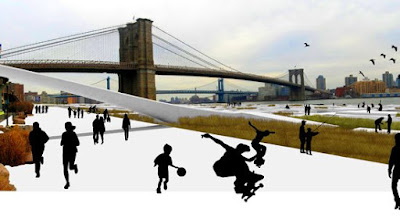 Imagesby N.E.E.D
Imagesby N.E.E.DThanks to pruned and Bustler for the images.
related posts:
on urban agriculture here, here and here and recently on aqua-culture
Tuesday, July 22, 2008
HOTEL OF DOOM WAKES FROM COMA
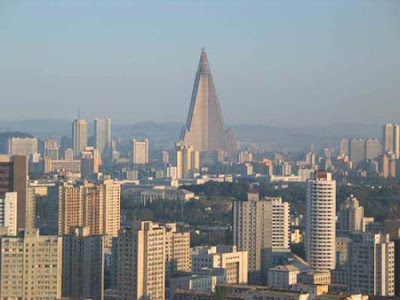 the 105-storey Ryugyong Hotel in North Corea's capital Pyongyang
the 105-storey Ryugyong Hotel in North Corea's capital PyongyangNorth Korea is refurbishing the "the worst building in the history of mankind" after a 16 year break.
the three sided pyramid that dominates Pyongyang's skyline used to be the number one prestige project of Korea's leader Kim Il-sung. after losing the sowjets as their main supporters the construction had to pause. just until now: Kim Il-sung's son Kim Jong-il decided to put the hotel back under construction.
one of many questions: who will dwell in that 3000-room giant in a country that basically does not except tourists?
"...Bruno Giberti, associate head of California Polytechnic State University's Department of Architecture, said the project was typical of what has been produced recently in many cities trying to show their emerging wealth by constructing gigantic edifices that were not related in scale to anything else around them."
thanks to yahoo news for the info - link
watch this great movie referring to the hotel of doom.
the utopian vision of north korea's future once it's open to the global market
thanks for the movie - link
Monday, July 21, 2008
! MAP THIS ! #8 - SHRINKING CITIES
World Map of Shrinking Cities from 1kilo on Vimeo.
Shrinking cities is a project (2002-2008) of the Federal Cultural Foundation, under the direction of Philipp Oswalt (Berlin) in co-operation with the Leipzig Gallery of Contemporary Art, the Bauhaus Dessau Foundation and the magazine archplus.
Moving Datas from 1kilo on Vimeo.
Thanks to Digital Urban for the link
Sunday, July 20, 2008
HYDRO VISONS
 A project already discussed a lot a few month ago, but worth to remember: the hydro-net vison for San Francisco 2108 by IwamotoscottArchitecture. See related article on Inhabitat.
A project already discussed a lot a few month ago, but worth to remember: the hydro-net vison for San Francisco 2108 by IwamotoscottArchitecture. See related article on Inhabitat. The architect's Flickr photo set also provides a deeper insight into to project.
While this project takes advantage out of natural processes by growing seaweed, algae and chanterelle mushroom the atmospheric physicist Carl Hodges believes that salicornia will be the natural resource for future energy supply.
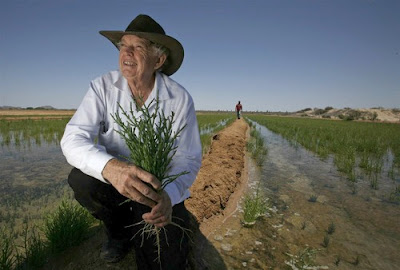 Salicornia is a crop nourished by ocean water that holds the potential to provide food and fuel to millions. See related article 'The man who farms with the sea' by LA Times
Salicornia is a crop nourished by ocean water that holds the potential to provide food and fuel to millions. See related article 'The man who farms with the sea' by LA Times
excursus II
Directed by James Frost
From the album IN RAINBOWS
Thanks to information aesthetics for the link
Saturday, July 12, 2008
postscript URBAN FLORA
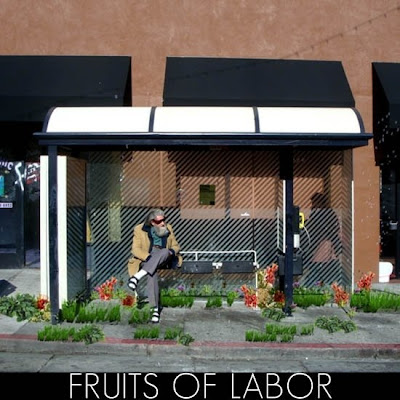 subtle subversive urban seeding. Have a look at: Bloom: Peddling Green
subtle subversive urban seeding. Have a look at: Bloom: Peddling GreenThe Bloom device is meant to be a subversive and inspirational tool for our concrete jungles. Similar to the tuft of a dandelion as the wind carries the seedling, we propose a way of dispersing seedlings with bubbles and bicycling.

related: Urban Flora's High Speed Evolution, Urban Agriculture
Wednesday, July 9, 2008
URBAN FLORA'S HIGH SPEED EVOLUTION
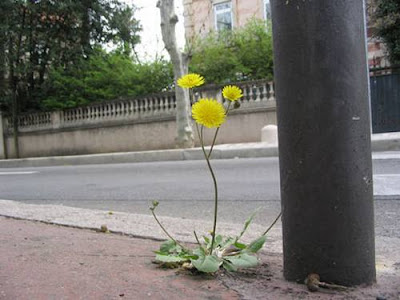
recent studies show that weeds are able to adapt to urban conditions very rapidly. reason for this is the split-up of their habitat. but for them this is not a problem at all: instead of investing energy in complex flying divices to fan out (such as the so called Holy Pippau/crepis sancta does), they focus on creating seeds that are heavy enough to fall down from the plant directly and germinate at the same location. makes sense, since it is not very likely the flying seeds will fall down on a piece of fertile soil.
remarkably is that this process of adaptation from rural to urban only takes a few seasons!
so now we know. not only humans are capable to adjust to city life...
Tuesday, July 8, 2008
WHEN ARCHITECTS MEET AUTOCRATS
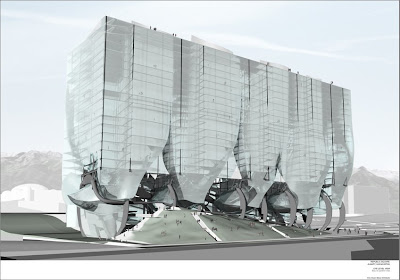 Republic Square Kazakhstan by E.O. Moss
Republic Square Kazakhstan by E.O. Moss...some architects argue that architecture is more important to them than politics. “I’m a guy who has on my wall a picture of the guy in front of the tank,” said Eric Owen Moss, a Los Angeles architect, referring to the famous photograph from the Tiananmen Square protests of 1989. “But I’ve never turned down a project in Russia and China.”...
???????
link
Saturday, July 5, 2008
excursus I
Digital Kitchen.
a digital media firm responsible for Six Feet Under's great opening credits. An Artwork itself.
Also the opening sequence of Dexter is worth a look.
HYDROLOGICAL HEALING
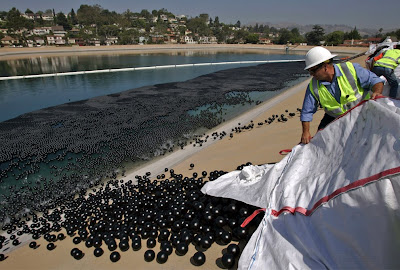 These images appeared recently relating to a project in Los Angeles, related to the restoration of water reservoir levels of bromate. A new approach is the use of sun-block, in the form of plastic balls, that limit the mixing of bromide and chlorine which is causing elevated levels of bromate.
These images appeared recently relating to a project in Los Angeles, related to the restoration of water reservoir levels of bromate. A new approach is the use of sun-block, in the form of plastic balls, that limit the mixing of bromide and chlorine which is causing elevated levels of bromate.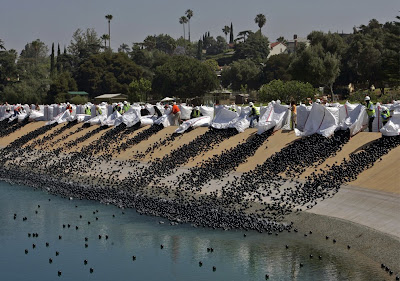
"Department of Water and Power workers are emptying out bales of plastic balls in the Ivanhoe reservoir in Los Angeles on Monday, June 9, 2008. Department of Water and Power released about 400,000 black plastic 4-inch balls as the first installment of approximately 3 million to form a floating cover over 7 acres of the reservoir to protect the water from sunlight. When sunlight mixes with the bromide and chlorine in Ivanhoe's water, the carcinogen bromate can form."source Boston.com and Landscape+Urbanism blog
Monday, June 16, 2008
! MAP THIS ! #7 BIGGEST DRAWING IN THE WORLD
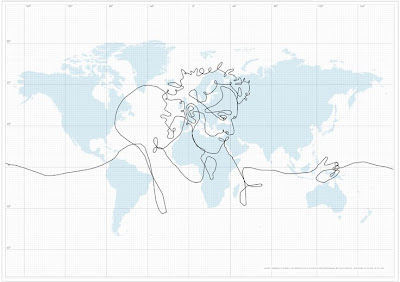 Erik Nordenankar about his huge drawing:
Erik Nordenankar about his huge drawing:With the help of a GPS device and DHL, I have drawn a self portrait on our planet. My pen was a briefcase containing the GPS device, being sent around the world. The paths the briefcase took around the globe became the strokes of the drawing.
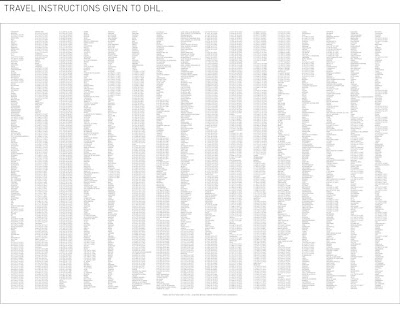 As the author notes on his website, this is fictional work. The GPS device was never sent. And any resemblences with the-world-is-my-canvas project (also worth a glimpse) are occasional.
As the author notes on his website, this is fictional work. The GPS device was never sent. And any resemblences with the-world-is-my-canvas project (also worth a glimpse) are occasional.
Friday, June 6, 2008
WIND OF CHANGE
 Sail ships are back.
Sail ships are back.A cargo ship with wind in its sails will take to the high seas, carrying the hopes of the shipping industry for a clean and green future free from the dependency on oil.
It's no ordinary clipper replete with rigging and tons of canvas. The MV Beluga, due to sail on its maiden voyage from the German port of Bremen across the Atlantic to Venezuela, is closer to a kite-surfer on steroids. Giant sails of 160 square meters complement the Beluga's existing power plant; the more wind, the less fuel is used.
Developed by SkySail, the propulsion technology is based on a similar concept to paragliding. It consists of a towing kite with a rope, a launch and recovery system and a control system for automatic operation. With future kite sails up to 600 square meters being proposed, it will cut fuel consumption in half in the right conditions. A significant advantage of the SkySail technology is it can be retrofitted to virtually all existing cargo ships and the force it exerts is similar to that of a tug.
:: via smart planet

Wednesday, May 21, 2008
! MAP THIS ! #6
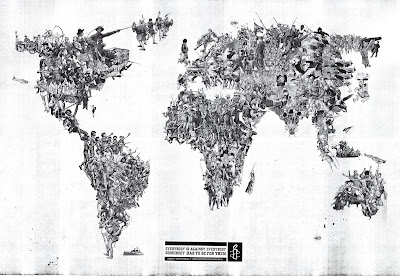 'Everybody Is Against Everybody – Somebody Has To Be For Them'
'Everybody Is Against Everybody – Somebody Has To Be For Them'Amnesty International's United Nations of War
Click image to enlarge, it's worth it!
Monday, May 19, 2008
POST-WATER BARCELONA
 Do you remember the plan to import water to the city because of the severe drought? It's no longer being considered; it's being carried out.
Do you remember the plan to import water to the city because of the severe drought? It's no longer being considered; it's being carried out.A ship loaded with drinking water is seen docked in the northern Spanish port of Barcelona, Spain Tuesday, May 13, 2008 as part of an unprecedented emergency plan to alleviate a drought in Barcelona. The ship was carrying some 20,000 cubic meters (5.3 million US gallons) of water, roughly enough to satisfy a day's requirements for 180,000 people, from nearby Tarragona. Spain is suffering its driest spring since records began 60 years ago. Catalonia is one of the worst-hit regions, with reservoirs at about a fifth of their capacity, compared with reservoirs on average half-full nationally. Read the Guardian's article
Sunday, May 18, 2008
! MAP THIS ! #5
 relative densities of Internet connectivity across the globe. The stronger the contrast, the more connectivity there is.
relative densities of Internet connectivity across the globe. The stronger the contrast, the more connectivity there is.The Dimes Project provides several excellent data sets that describe the structure of the Internet. Using their most recent data at the time (Feb 2007), Chris Harrison created a set of visualizations that display how cities across the globe are interconnected (by router configuration and not physical backbone). In total, there are 89,344 connections
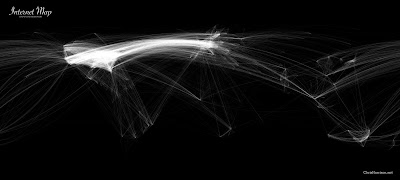 World City-to-City Connections
World City-to-City Connections European City-to-City Connections
European City-to-City Connections North American City-to-City Connections
North American City-to-City Connections



